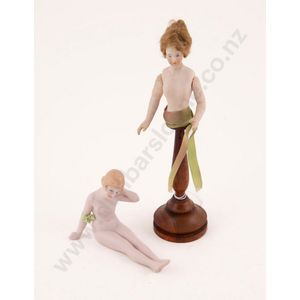German Bisque Half Head Dolls and Art Deco Nude
Two German bisque half head dolls, half head with moving arms, mohair wig and full figured Art Deco nude (repair to arm) 7 cm, 9 cm length
You must be a subscriber, and be logged in to view price and dealer details.
Subscribe Now to view actual auction price for this item
When you subscribe, you have the option of setting the currency in which to display prices to $Au, $US, $NZ or Stg.
This item has been sold, and the description, image and price are for reference purposes only.
- Art Deco Period - The Art Deco period was a cultural movement that emerged in the 1920s and 1930s, and was characterized by its emphasis on modernism, luxury, and elegance. The name "Art Deco" comes from the Exposition Internationale des Arts Décoratifs et Industriels Modernes, a large exhibition held in Paris in 1925 that showcased the latest trends in decorative arts.
Art Deco was a reaction against the ornate and elaborate styles of the previous era, and reflected a new modern sensibility. It was characterized by streamlined, geometric shapes, bright colours, and the use of new materials such as chrome, glass, and Bakelite. Art Deco designers sought to create a sense of luxury and sophistication, often incorporating expensive materials such as ivory, marble, and rare woods.
Art Deco had a significant impact on a wide range of artistic fields, including architecture, fashion, graphic design, and interior design. Some of the most iconic examples of Art Deco architecture include the Empire State Building in New York City, the Hoover Building in London, and the Palais de Chaillot in Paris.
The Art Deco period came to an end in the 1940s, as World War II and changing cultural trends led to a shift in artistic styles. However, Art Deco remains an important influence on design and art, and continues to be celebrated for its modernist sensibility and glamorous aesthetic. - Mohair - Mohair is a type of fabric or yarn that is made from the hair of the Angora goat. Mohair is known for its softness, luster, and durability, and it is often used in high-end fashion and textile products.
The Angora goat is native to Turkey, but it is now raised in many parts of the world, including South Africa, the United States, and Australia. The goats are sheared twice a year to harvest their long, silky hair, which can be up to 30 cm (12 inches) in length.
The hair is then spun into yarn, which can be woven or knitted into fabrics for clothing, blankets, and other textiles. Mohair is often blended with other fibers, such as wool or silk, to improve its strength and texture.
Mohair is prized for its softness, which comes from the fine, tightly curled fibers of the Angora goat's hair. The fibre is also naturally lustrous, with a shiny, almost metallic appearance. Mohair is also highly durable and resistant to moisture, making it a popular choice for high-end fashion products such as suits, coats, and evening wear.
This item has been included into following indexes:
